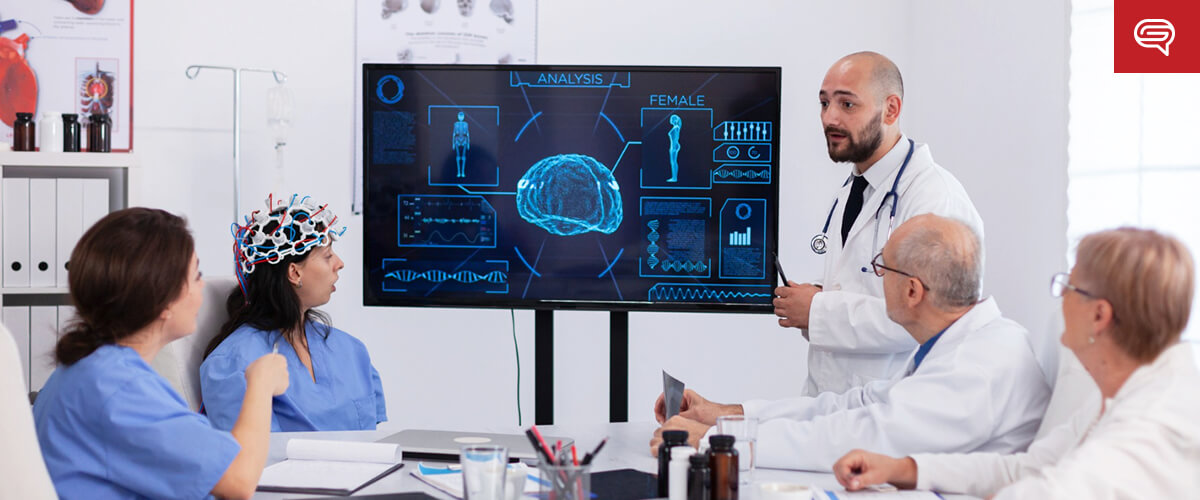
In healthcare, data is crucial for decision-making, innovation, and patient care. However, presenting complex medical data clearly and understandably can be challenging. Effective communication of this data is essential for healthcare professionals, stakeholders, and patients. Let’s explore strategies to simplify complex medical data in healthcare presentations, enhancing clarity, engagement, and impact.
Need a Presentation Designed?
Click Here To View Our Amazing Portfolio
Why Simplifying Medical Data Matters
Better Decision-Making
Clear data presentation helps healthcare professionals make informed decisions.
Improved Communication
Simplified data enhances communication among medical teams, stakeholders, and patients.
Increased Engagement
Engaging healthcare presentations capture attention, making information more memorable and actionable.
Accuracy and Compliance
Accurate data interpretation is crucial for regulatory compliance and patient safety.
Strategies for Simplifying Medical Data
Understand Your Audience
Tailor your presentation to the audience’s level of expertise. Medical professionals can handle more technical details, while patients or stakeholders may need simpler explanations.
- Assess Expertise Level: Gauge whether your audience consists of healthcare professionals, administrative staff, patients, or a mix. This helps determine the depth and complexity of information to present.
- Customized Content: Create different versions of your presentation if addressing diverse groups, ensuring each version aligns with the specific needs and comprehension levels of the audience.
Use Clear, Simple Language
Avoid medical jargon and complex terms unless necessary. When technical terms are used, provide clear definitions and explanations to make the content accessible.
- Plain Language: Translate complex medical terminology into plain language without diluting the meaning. For example, use “high blood pressure” instead of “hypertension” when speaking to non-professionals.
- Glossaries and Definitions: Include a glossary or define terms as you go along. This helps prevent confusion and ensures that all audience members are on the same page.
Incorporate Visual Aids
Visual aids can effectively convey complex data. Charts, graphs, infographics, and diagrams can simplify information, making it easier to understand.
- Charts and Graphs: Use various types of charts to present statistical data. Ensure axes are labeled, legends are included, and data points are easy to interpret. For instance, a line graph can show trends over time, while a bar chart can compare different categories.
- Infographics: Combine visuals and concise text to summarize processes or illustrate relationships. Infographics are particularly useful for breaking down complex concepts into easily digestible pieces.
- Diagrams: Use diagrams to depict anatomical structures, medical procedures, or data flow. Diagrams should be simple, with key parts labeled clearly to avoid overwhelming the audience.
Tell a Story
Use storytelling to guide your audience through the data, highlighting key points and their implications. This approach makes the data more relatable and easier to comprehend.
- Narrative Structure: Structure your presentation with a clear beginning, middle, and end. Start with an introduction to the topic, present the data, and conclude with key takeaways and implications.
- Case Studies: Incorporate real-life examples or case studies to illustrate how the data applies in practical scenarios. This helps the audience connect with the material on a personal level.
- Analogies and Metaphors: Use analogies and metaphors to explain complex concepts. For example, compare the human body’s immune system to an army defending against invaders to make the concept more relatable.

Highlight Key Takeaways
Emphasize main points and key takeaways using bullet points, bold text, or color highlights. This helps the audience focus on the most important information.
- Summary Slides: Include summary slides at the end of each section or at the conclusion of your presentation to reinforce key points.
- Visual Emphasis: Use visual cues such as bold text, colored highlights, or icons to draw attention to important information. This makes it easier for the audience to identify and remember key takeaways.
Interactive Elements
Include interactive elements like Q&A sessions, polls, or live demonstrations to engage your audience. These features make the presentation dynamic and provide opportunities for clarification.
- Q&A Sessions: Allocate time for questions and answers to address any doubts or provide further clarification on complex points.
- Live Polls: Use live polls to gather audience feedback or gauge understanding in real time. This can make the presentation more interactive and engaging.
- Hands-On Demonstrations: If applicable, incorporate hands-on demonstrations or simulations to help the audience grasp complex concepts more effectively.
Utilize Technology
Leverage tools like PowerPoint for advanced data visualization and interactivity. You may consider using augmented reality (AR) or virtual reality (VR) for immersive experiences.
- Advanced Software: Utilize presentation software that offers advanced features for data visualization and interactivity. For example, tools like microapps can create dynamic and interactive charts and graphs.
- AR/VR: Explore the use of augmented reality (AR) or virtual reality (VR) to provide immersive experiences, especially for complex topics like surgical procedures or anatomical studies. This technology can help audiences visualize and understand intricate details more engagingly.
Ensure Data Integrity
Verify the accuracy and reliability of the data presented. Double-check facts, figures, and sources to maintain credibility and foster trust.
- Source Verification: Ensure that all data is sourced from credible and reliable sources. Cross-check information to avoid discrepancies.
- Accurate Representation: Present data accurately without distortion. Avoid manipulating charts or graphs in a way that could mislead the audience.
Seek Feedback
Before the final presentation, seek feedback from colleagues or a test audience. Constructive feedback can help identify areas needing simplification or further clarification.
- Mock Presentations: Conduct mock presentations to gather feedback on clarity, engagement, and overall effectiveness.
- Iterative Improvement: Use the feedback to make necessary adjustments and improvements. Iterative refinement ensures that the final presentation is polished and effective.
Need a Presentation Designed?
Click Here To View Our Amazing Portfolio
Demystifying complex medical data in healthcare presentations is essential for effective communication and decision-making. Adopt these strategies to create impactful healthcare decks that simplify complex medical data, ensuring your audience can understand and act on the information provided.





